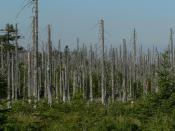Acids form when certain atmospheric gases come into contact with water in the atmosphere or on the ground and are chemically converted to acidic substances. Oxidants play a big part in many acid-forming processes. Carbon dioxide dissolved in rain is converted to a weak acid (carbonic acid). Other gases, primarily oxides of sulfur and nitrogen, are converted to strong acids (sulfuric and nitric acids).
Although rain is naturally slightly acidic, human activities can make it much more acidic.
The principal natural phenomena that create acid-producing gases in the atmosphere are emissions from volcanoes and from biological processes that occur on the land, wetlands and oceans. The effects of thousands of years old acidic deposits have been detected in glacial ice in distant parts of the earth. The most important human sources are industrial and power-generating plants and transportation vehicles.
Since the industrial revolution, emissions of sulfur and nitrogen oxides to the atmosphere have increased.
Industrial and energy-generating facilities that burn fossil fuels, primarily coal, are the principal sources of increased sulfur oxides. These sources together with transport are the major originators of increased nitrogen oxides.
The problem of acid rain has not only increased with population and industrial growth; it has become more widespread. The use of tall smokestacks to reduce local pollution has contributed to the spread of acid rain by releasing gases into regional atmospheric circulation.
Occasional pH readings below have been reported in industrialized areas.
What is it made of?
Natural acid rain.
Water contains some acid (CO2) naturally due to decomposing of organic substances. CO2 dissolves in water and makes up carbonic acid. Other reasons for acidity are volcano eruptions, forest fires, lightning storms. Clean rain pH is around 5.6.
Unnatural acid rain.
Unnatural acid is caused by the release of oxides of nitric oxide...


